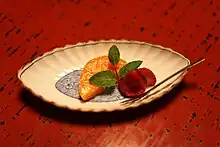
Setoka (せとか, Setoka)[1] is a seedless and highly sweet Japanese citrus fruit that is a tangor, a hybrid of the Murcott tangor with "Kuchinotsu No.37",[2] which in turn is a hybrid of the Kiyomi tangor and a King tangor/Willowleaf mandarin cross, "Encore No. 2".[3][4] It was registered as "Tangor Nōrin No.8"[5] in 1998 and as "Variety registration No.9398" under the Plant Variety Protection and Seed Act[6] in 2001.[4] It weighs 200–280 g (7.1–9.9 oz) and has an oblate shape. The rind is thin and easily peelable. Its flavor is pleasant, aromatic, and similar to the Murcott. The fruit ripens in February. Its sugar level is very high at 12–13 °Bx whereas its citric acid is low (0.8–1.0%).[4]
Outside Japan
In South Korea, Setoka is called Cheonhyehyang (천혜향, 天惠香).[7]
See also
- Reikou, a Citrus cultivar of similar origin
References
- ↑ "せとか" [Setoka] (in Japanese). National Institute of Fruit Tree Science, National Agriculture and Food Research Organization. Archived from the original on 2015-03-03. Retrieved 2015-03-10.
- ↑ (口之津37号)
- ↑ Encore and Pixie in California Agriculture (PDF). University of California. February 1966.
- 1 2 3 Matsumoto, Ryōji; et al. (2003). "New Citrus Cultivar "Setoka"" (PDF). Bulletin of Fruit Tree Science (in Japanese). National Institute of Fruit Tree Science Japan. 2: 25–31.
- ↑ Tangor agricultural and forestry No.8 (タンゴール農林8号)
- ↑ "Plant Variety Protection and Seed Act". Ministry of Justice, Japan.
- ↑ "당도 최고 천혜향 지금이 최고의 맛".